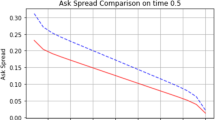Abstract
A one-sided limit order book is modeled as a noncooperative game for several players. Agents offer various quantities of an asset at different prices, competing to fulfill an incoming order, whose size is not known a priori. Players can have different payoff functions, reflecting different beliefs about the fundamental value of the asset and probability distribution of the random incoming order. In a previous paper, the existence of a Nash equilibrium was established by means of a fixed point argument. The main issue discussed in the present paper is whether this equilibrium can be obtained from the unique solution to a two-point boundary value problem, for a suitable system of discontinuous ordinary differential equations. Some additional assumptions are introduced, which yield a positive answer. In particular, this is true when there are exactly two players, or when all players assign the same exponential probability distribution to the incoming order. In both of these cases, we also prove that the Nash equilibrium is unique. A counterexample shows that these assumptions cannot be removed, in general.

Similar content being viewed by others
References
Bach, K., Baruch, S.: Strategic liquidity provision in limit order markets. Econometrica 81, 363–392 (2013)
Cont, R., Stoikov, S., Talreja, R.: A stochastic model for order book dynamics. Oper. Res. 58, 549–563 (2010)
Obizhaeva, A., Wang, J.: Optimal trading strategy and supply/demand dynamics, J. Financ. Markets 16, 1–32 (2013)
Predoiu, S., Shaikhet, G., Shreve, S.: Optimal execution in a general one-sided limit-order book. SIAM J. Financ. Math. 2, 183–212 (2010)
Preis, T., Golke, S., Paul, W., Schneider, J.J.: Multi-agent-based order book model of financial markets. Europhys. Lett. 75, 510–516 (2006)
Rosu, I.: A dynamic model of the limit order book. Rev. Financ. Stud. 22, 4601–4641 (2009)
Bressan, A., Facchi, G.: A bidding game in a continuum limit order book. SIAM J. Control Optim. 51, 3459–3485 (2013)
Bressan, A., Facchi, G.: Discrete bidding strategies for a random buying order. SIAM J. Financ. Math. 5, 50–70 (2014)
Bressan, A.: Noncooperative differential games. Milan J. Math. 79, 357–427 (2011)
Dockner, E.J., Jorgensen, S., Long, N.V., Sorger, G.: Differential Games in Economics and Management Science. Cambridge University Press, Cambridge (2000)
Wang, J.: The Theory of Games. Oxford University Press, New York (1988)
Kamke, E.: Zur Theorie der Systeme gewöhnlicher Differentialgleichungen II. Acta Math. 58, 57–85 (1932)
Acknowledgments
This research was partially supported by NSF, with Grant DMS-1108702: “Problems of Nonlinear Control”.
Author information
Authors and Affiliations
Corresponding author
Additional information
Communicated by Moawia Alghalith.
Rights and permissions
About this article
Cite this article
Bressan, A., Wei, D. A Bidding Game with Heterogeneous Players. J Optim Theory Appl 163, 1018–1048 (2014). https://doi.org/10.1007/s10957-014-0551-5
Received:
Accepted:
Published:
Issue Date:
DOI: https://doi.org/10.1007/s10957-014-0551-5
Keywords
- Optimality conditions
- Discontinuous ODE
- Optimal pricing strategy
- Bidding game
- Nash equilibrium
- Limit order book




